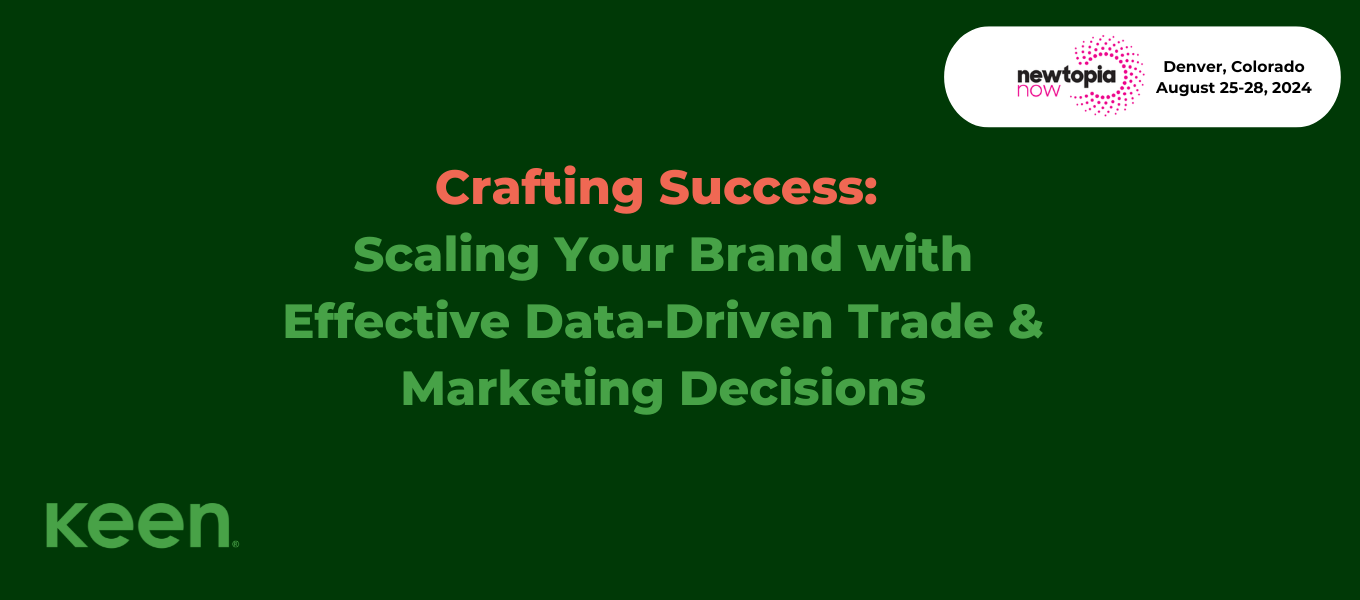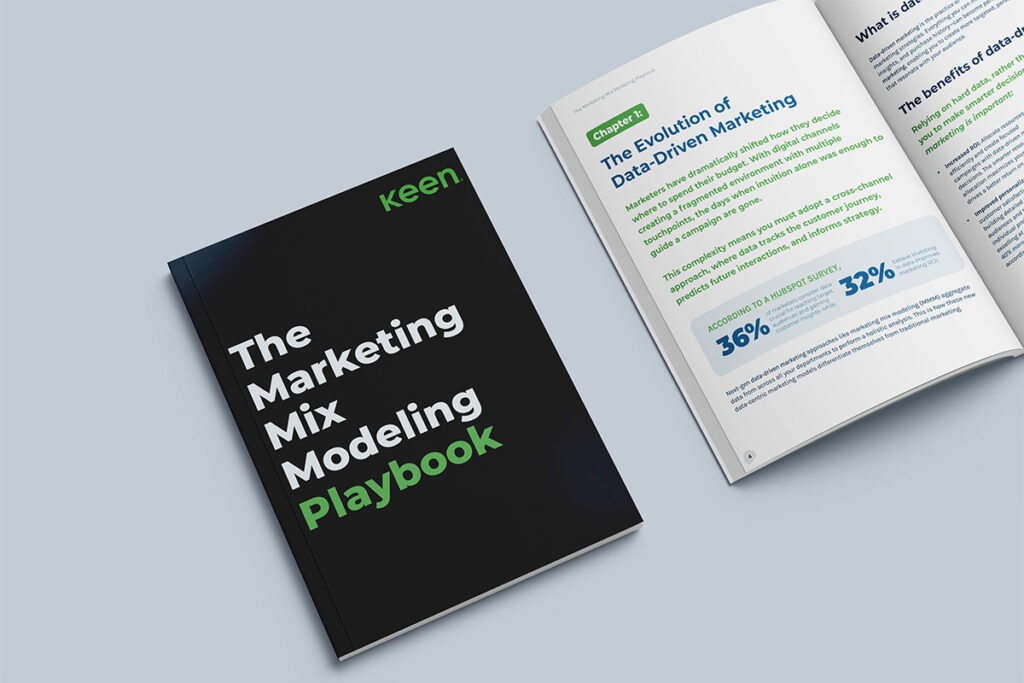In today’s data-driven era, businesses of all sizes are undergoing a significant transformation in their approach to making marketing decisions. A panel discussion at Newtopia Now 2024 in Denver brought together industry experts to explore this shift and its profound impact on brand growth and maturity.
The panel featured:
- Bradley Keefer, Chief Revenue Officer at Keen Decision Systems
- Jon Tanklage, President of Marukan Vinegar
- Alyshah Walji from Vividly
These leaders shared valuable insights on how innovative mindsets and data-driven approaches are reshaping marketing strategies across industries.
Latest trends in the decision process in marketing
Here are the top 5 trends emerging in the marketing decision making process:
1. Relying on data-driven decisions
One of the key themes that emerged from the discussion was the importance of shifting from intuition-based to data-driven marketing. As Bradley Keefer pointed out, “Keen enables marketers to shift from defending budgets to consistently demonstrating their impact on the bottom line.”
This shift isn’t about abandoning intuition entirely, but rather about validating and enhancing it with hard data. For brands with limited resources, this means every marketing dollar can be allocated more effectively.
2. Optimizing budgets in a changing market
Regardless of a company’s size, marketing spend optimization is crucial. Jon Tanklage shared his experience with Marukan Vinegar:
“Keen shows how things change rapidly in even what we think are really stable channels. It allows us to make adjustments as the market changes.”
The real-time adjustments marketers can make within the Keen platform ensure agility in marketing. No marketing dollar is wasted as a result of various environmental factors and every dollar is stretched as far as it can go.
This adaptability is vital in today’s fast-paced business environment. For brands looking to maximize the impact of their marketing budgets, the Keen platform can be game-changing. But the benefits of this data-driven marketing approach extend far beyond just budget optimization.
3. Bridging the gap between marketing decision-makers and finance
By enabling marketers to quantify the incremental impact of every marketing dollar spent, Keen’s platform changes the dynamic between marketing and finance departments. This quantifiable approach empowers marketers to have more productive conversations with CFOs and other stakeholders.
Instead of defending budgets, marketers can demonstrate their marketing ROI and how their efforts directly contribute to the company’s financial goals—a shift that can be particularly impactful for businesses where resources are limited. As Keefer noted in the panel, this visibility not only improves decision-making but also fosters alignment between departments, breaking down silos across the organization.
Read more: 3 strategies CMOs can implement to showcase marketing performance to the CFO
4. Saving costs through automation
The benefits of this unified, data-driven approach extend to operational efficiencies as well. Jon Tanklage highlighted another crucial advantage: “What today’s systems are good at is automation. This takes away labor costs. You will ultimately save because you won’t have to employ multiple people to achieve the same objective.”
Instead of maintaining large teams to manage different marketing channels, companies can operate with smaller, more focused teams. This not only leads to significant labor cost savings but also allows businesses to allocate resources more strategically and allows for organizations to align closely on business goals.
5. Getting clear views for informed investment strategies
The panel emphasized how these modern AI-powered marketing tools are helping key decision-makers across the board. Alyshah Walji from Vividly summed it up: “Tools like Vividly and Keen give businesses clear views into their operations and help inform investment strategies.”
This sentiment was echoed by Bradley Keefer, who explained how Keen’s platform allows marketers to see the incremental impact of their efforts across different channels. By leveraging these data-driven insights, businesses can make more informed marketing investment decisions about where to allocate their resources, ensuring that every dollar spent contributes effectively to growth and profitability.
Supercharge your marketing decision process with Keen
Data-driven marketing tools, like Keen, will play an increasingly central role in business and marketing mix strategy. They offer the insights and optimization capabilities necessary to compete in rapidly changing markets while also providing the concrete evidence needed to justify and optimize marketing spend.
For companies like Marukan Vinegar, embracing these tools has opened new avenues for growth and efficiency. As more businesses follow suit, we can expect to see a continued evolution in how marketing decisions are made, budgets are allocated, and strategies are formed.
In this new landscape, the most successful marketing decision-makers will be those who can harness the power of data to drive meaningful business outcomes, all while maintaining the creativity and human touch that defines great marketing. By optimizing budgets, adapting to market changes, quantifying marketing impact, and breaking down organizational silos, platforms like Keen are not just changing how we market—they’re transforming how businesses of all sizes operate and compete in today’s dynamic environment.
Want to learn how Keen can shift your approach to the marketing decision process? Request a demo today.
Frequently asked questions
What are marketing decisions?
Marketing decisions are the strategic choices businesses make to connect with their target audience and achieve their business goals. Understanding your customers’ needs and making informed choices about how to reach them effectively is essential for success. These decisions shape how you position your products or services, communicate value, and build lasting relationships with customers.
Examples of common marketing decisions include:
- Selecting target markets and creating detailed customer personas
- Setting product pricing strategies and promotional offers
- Choosing marketing channels (social media, email, print, etc.)
- Allocating marketing budget across different campaigns
- Developing brand messaging and visual identity
- Determining content strategy and publication schedule
- Selecting metrics to measure marketing effectiveness
- Deciding on partnerships and influencer collaborations
Making smart marketing decisions requires analyzing data, understanding market trends, and staying aligned with your overall business objectives.
What are the types of marketing decisions?
Every business faces key marketing decisions that shape their success in the market. Understanding these different types helps you make more strategic choices for your brand. Here are the four main categories of marketing decisions you’ll encounter:
- Product decisions determine what you offer customers, including features, quality, packaging, and branding. These choices directly impact how your customers perceive and experience your offering.
- Price decisions establish your value in the market through strategies like premium pricing, competitive pricing, or penetration pricing. Your pricing affects both your profitability and market position.
- Place decisions focus on how customers access your product, from distribution channels to location strategy. Making the right choices here ensures your offering reaches customers effectively.
- Promotion decisions cover how you communicate with your audience through advertising, content marketing, PR, and sales promotions. These choices help you build awareness and drive customer engagement.
What are the steps of the decision process in marketing?
Successfully navigating marketing decisions requires a clear, systematic approach. By following these steps, you’ll be equipped to make confident choices that drive results for your business.
1. Identify the opportunity or challenge: Start by clearly defining what needs to be addressed, whether it’s launching a new product or improving customer engagement.
2. Gather and analyze data: Collect relevant market research, customer insights, and competitor analysis to inform your decision-making.
3. Define your objectives: Set specific, measurable goals that align with your overall business strategy.
4. Develop multiple options: Generate various potential solutions or approaches to achieve your objectives.
5. Evaluate alternatives: Assess each option based on factors like cost, potential impact, and feasibility.
6. Make and implement your decision: Choose the best option and create a detailed action plan.
7. Monitor and adjust: Track results against your objectives and make adjustments as needed to optimize performance.
How does MMM enable better marketing decision-making?
Marketing Mix Modeling (MMM) empowers you to make data-driven decisions by revealing exactly how your marketing investments impact business outcomes. Instead of relying on gut feelings, MMM gives you clear insights into which channels and tactics truly drive results.
Keen’s Marketing Mix Modeling platform transforms this complex analysis into actionable insights you can trust. It analyzes your historical data to show how different marketing activities – from social media to TV advertising – contribute to your sales and ROI. This understanding helps you:
- Optimize your marketing budget allocation across channels
- Predict the impact of future marketing investments
- Identify which channels work best together
- Understand external factors affecting your performance
- Make confident decisions about marketing strategy
Armed with these insights, you can make smarter decisions about where to invest your marketing dollars, eliminate wasteful spending, and maximize your return on investment. The platform’s clear recommendations help you take immediate action to improve your marketing performance.





